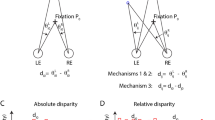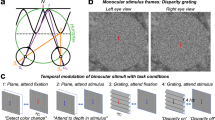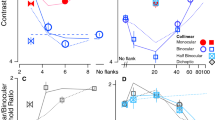Abstract
WHAT features in a stereogram define the disparities that lead to stereoscopic depth? The usual answer is that luminance-defined edges from the two eyes are matched and produce depth perception1,2. But parts of an object may be occluded by other objects and absent from one eye's view. It was suggested that unpaired monocular elements might signal occlusion in depth, and the qualitative perception of depth associated with unmatched elements has been shown to be consistent with the geometry of occlusion3–5. We designed a stereogram that simulates a particular in front of a large black rectangle pasted on a white background. The position of the occluder is adjusted so that its left edge obscures the left-hand edge of the black rectangle in the right eye view and its right edge obscures the right-hand edge of the black rectangle in the left eye view. We report here that quantitative stereopsis can be seen from this stereogram, even though there are no binocular corresponding luminance edges to match.
This is a preview of subscription content, access via your institution
Access options
Subscribe to this journal
Receive 51 print issues and online access
$199.00 per year
only $3.90 per issue
Buy this article
- Purchase on Springer Link
- Instant access to full article PDF
Prices may be subject to local taxes which are calculated during checkout
Similar content being viewed by others
References
Julesz, B. Foundations of Cyclopean Perception (University of Chicago Press, Chicago, London, 1971).
Marr, D. & Poggio, T. A. Proc. R. Soc. B204, 301–328 (1979).
Shimojo, S. & Nakayama, K. Vision Res. 30, 69–80 (1990).
Nakayama, K. & Shimojo, S. Vision Res. 30, 1811–1825 (1990).
Nakayama, K. & Shimojo, S. Cold Spring Harb Symp. quant. Biol. 55, 911–924 (1990).
Harris, C. S. & Gregory, R. L. Perception 2, 235–247 (1973).
Ramachandran, V. S. Percept. Psychophys. 39, 361–373 (1986).
Ramachandran, V. S. & Cavanagh, P. Nature 317, 527–530 (1985).
Ramachandran, V. S., Rao, V. M. & Vidyasagar, T. R. Nature 242, 412–414 (1973).
Kellman, P. J. & Shipley, T. F. Cognitive Psychology 23, 141–221 (1991).
Treisman, A. Q. J. exp. Psychol. 14, 23–37 (1962).
Barlow, H. B., Blakemore, C. & Pettigrew, J. D. J. Physiol., Lond. 193, 327–342 (1967).
Poggio, G. F. & Fischer, B. J. Neurophyslot. 40, 1392–1407 (1977).
Takeichi, H., Watanabe, T. & Shimojo, S. Perception 21, 177–184 (1992).
Author information
Authors and Affiliations
Rights and permissions
About this article
Cite this article
Liu, L., Stevenson, S. & Schor, C. Quantitative stereoscopic depth without binocular correspondence. Nature 367, 66–69 (1994). https://doi.org/10.1038/367066a0
Received:
Accepted:
Issue Date:
DOI: https://doi.org/10.1038/367066a0
This article is cited by
-
How owls structure visual information
Animal Cognition (2003)
-
Human stereovision without localized image features
Biological Cybernetics (1995)
Comments
By submitting a comment you agree to abide by our Terms and Community Guidelines. If you find something abusive or that does not comply with our terms or guidelines please flag it as inappropriate.



